 General
General  General Archive
General Archive  64 Since '64: Top Players of Cleveland's Title Drought Era: Rd 1, Pt 4
64 Since '64: Top Players of Cleveland's Title Drought Era: Rd 1, Pt 4
As we bring the first round of the tournament to a close, Jeff Ellis and Andrew Clayman move their attention to the Scarlet & Grey region of the bracket, where the voting proved considerably closer than in any other regional. If you'll recall, we're on a mission to narrow down the names of the greatest Browns, Indians, and Cavs players since the last Cleveland sports championship in 1964. In a few days, we'll be down to 32. Coincidentally, that's also the jersey number of our top seed in today's quarter of the draw, the legendary Jim Brown. Suffice it to say, he'll be moving on. But what about Julio Franco? Webster Slaughter? Cliff Lee?
Bracket Breakdown, Round 1, Part 4
By Andrew Clayman & Jeff Ellis
As we bring the first round of the tournament to a close, Jeff Ellis and I move our attention to the Scarlet & Grey region of the bracket, where the voting proved considerably closer than in any other regional. If you’ll recall, we’re on a mission to narrow down the names of the greatest Browns, Indians, and Cavs players since the last Cleveland sports championship in 1964. In a few days, we’ll be down to 32. Coincidentally, that’s also the jersey number of our top seed in today’s quarter of the draw, the legendary Jim Brown. Suffice it to say, he'll be moving on. But what about Julio Franco? Webster Slaughter? Cliff Lee? They’re on the bubble, so Jeff and I have no choice but to talk about it all in our latest long-winded, Mel Kiper-esque rant session.
Click Here to Vote In the 64 Since '64 Bracket, If You Haven't Already
So, here we go: the final eight match-ups of Round 1. I suppose our time might be better spent sharing our thoughts on the Browns' play calling or Delonte West’s current whereabouts, but we’ll stick to the pointless hypothetical crap instead. We know our limitations.
Archive: Brown & Orange Regional | Wine & Gold Regional | Red & Blue Regional
Round 1, Scarlet & Grey Regional
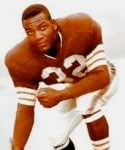
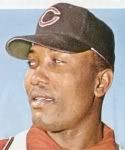
#1 Jim Brown vs #16 Leon Wagner
ANDREW CLAYMAN: Let’s attempt to forget the fact that Jim Brown is possibly the greatest football player of all-time and also a certified super badass. Some people are asking, quite fairly, whether members of the 1964 Championship team should really be in this tournament. Sure, Jim Brown won the MVP in 1965, but is he really tied to the Title Drought Era? I say “yes.” In that ’65 season, Brown’s last, Cleveland returned to the NFL Championship Game, but fell to Vince Lombardi’s Packers, 23-12, despite 100 all-purpose yards from Jim. A year later, something called the Super Bowl was invented, but with Brown retired, Green Bay suddenly had a much clearer path to NFL dominance. 45 years later, the Pack has its piece of Super Bowl history, and we’re still waiting for our first crack at one. Incidentally, the fun of this matchup is that Leon “Daddy Wags” Wagner, who had 4 strong years as the Indians left fielder from 1964-67, followed Jim Brown’s path into acting after his playing career was over. Shockingly, as further evidence of the Cleveland curse perhaps, neither man won an Oscar. JEFF ELLIS: No need to read too much of Jim Brown’s on-field resume yet. He doesn’t need it for this game. That’s no insult to Leon Wagner, though. When the charismatic left-fielder broke into baseball with the Giants, he played in maybe the best outfield ever assembled-- Willie Mays, Orlando Cepeda, Felipe Alou, and Bill White were all on the roster. Wagner learned from the best and became a very productive hitter for the Indians. Andy mentioned how both these athletes went on to Hollywood, but while they may not have won any Oscars, they did both star in films in which John Cassavetes was nominated for an Oscar (The Dirty Dozen and A Woman Under the Influence, respectively). What does that mean? I have no idea.

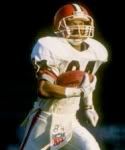
#8 Larry Nance vs #9 Webster Slaughter
AC: Much like the Clay Matthews vs Andre Thornton match-up, there’s something oddly sad about having to choose between these two stalwarts, whose parallel days in Cleveland are fondly remembered. When the ball was in the hands of Larry Nance or Webster Slaughter, good things tended to happen. They were reliable, smart, consistent, and when they needed to be—quite explosive. Slaughter, owner of one of the greatest YAC spin moves of his era and one of the greatest names EVER, was drafted in the second round by the Browns in 1986. He ranks 8th in team history in receptions and 9th in yards receiving, starring on all three Cleveland AFC Championship Game squads. Nance came over from Phoenix in 1987 and finished his career here in 1994. He made a couple All-Star teams and ranks 8th in Cavs history in points, 5th in boards, 3rd in field goal pct., and #1 in blocks per game at a whopping 2.5. It’s likely Larry’s career body of work that has him ahead in this match, but the Browns have been trying to replace Webster Slaughter since 1992.
JE: I don’t know how Andy can say we are still trying to replace Slaughter when there have been such luminaries as Michael Jackson, Andre Rison, Kevin Johnson, and (ooh, fresh off the wire) Braylon Edwards who’ve come and gone at the #1 receiver spot. Slaughter had the franchise’s single season yardage record until Edwards broke it in his one good year (2007), and he was yet another player whose contract dispute with Modell had him run out of town, where he went on to further success with the Oilers. Nance, on the other hand, was a glue player on the great Lenny Wilkens Cavs teams. Even though he was never better than a third option offensively, he still managed to make an All Star Team in Cleveland and provide a great defensive presence inside. Nance ended up going the way of his fellow big man Brad Daugherty-- forced out of the league thanks to his back and rejuvenated in the world of car racing (all those ACC guys loved their NASCAR). In the end, this is really a match-up of top tier players who weren’t fully appreciated until they were gone.
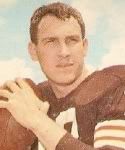
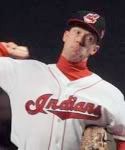
#4 Frank Ryan vs #13 Orel Hershiser
JE: To me at least, Frank Ryan is the best quarterback in this tourney. The Browns were truly lucky to acquire him from the Rams in 1962. While many fans might just look at stats and see that he didn’t put up huge numbers, they would neglect to look at the era in which he played. Everyone remembers Jim Brown on the last Cleveland championship team, but it was Ryan that got him and everyone else involved. Not bad at all for a 5th round pick out of the football powerhouse that is Rice, where he was never able to win the starting job over a guy named King Hill. Hill was the first pick in the draft in 1958; Ryan went #55. Jim Ninowski, whom Ryan replaced as the Browns starting QB, was also taken in that same draft at #49, proving the draft has never been an exact science. Orel, meanwhile, is a player who came to Cleveland on the decline, only to win over the city with his postseason efforts. He was dominating in 1995 versus the Mariners, winning the ALCS MVP (making him the only player to win that award in both leagues). Orel also served an almost equally valuable role a year earlier, though, when he agreed to sign as a free agent with the young Indians. At the time, a big name pitcher signing with Cleveland (even removed from his heyday) was unheard of. When he signed, along with Dennis Martinez, I knew the franchise had turned a corner. Even so, if you don’t vote for Ryan here, you need to do a little more research into the history of your football team.
AC: While a cross-generational quarterback conversation between Dr. Frank Ryan (owner of a PhD in mathematics) and Derek Anderson (dude) would no doubt be highly amusing, I think I’d rather hear the doctor talk game day brain waves with my fellow Bowling Green graduate Orel Hershiser, who resurrected himself to become the vocal leader of the greatest team in modern Tribe history. In this battle of the brains, Ryan clearly deserves the win, as Jeff says. Even if we discount his role as the QB on the last (ever?) Browns championship team, Ryan’s mid-60’s performance far outshines Hershiser’s brief Bulldog days at Jacobs Field. Dr. Frank made 3 Pro Bowls and ranks 4th all-time in passing in Browns history. Orel won 45 games in 3 years with the Indians and was mostly fantastic in postseason. Unfortunately, his last two appearances spoiled his reputation, as he was shelled for 13 runs and took two losses in the infamous ’97 World Series against Florida. Oh, you’d forgotten that? Sorry.
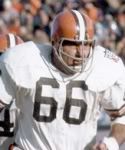

#5 Gene Hickerson vs #12 Mike Hargrove
JE: Offensive guard; is there any position in football that gets less publicity? I mean, even a punter gets more love for his work. A guard only gets name checked when he jumps the snap count. In retrospect, though, the Browns linemen of the ‘60s were incredible, paving the way for multiple Hall of Famers. Gene Hickerson in particular was the model of a durable player, never missing a game from 1963-1973. During his tenure on the Browns line, they never had a losing record and boasted the league’s leading rusher seven times. Hickerson made the NFL’s All-Decade team for the ‘60s. His opponent, Mike Hargrove, is more remembered for his time as manager then the time he played in Cleveland, but he was selected one of the 100 best players in Cleveland Indians history, and he was a fan favorite-- a smart player who did the little things and drove pitchers mad with his deliberate approach to the game. For this match-up, Hickerson looks to be the winner, but hardly by a landslide. Same old story for Gene, who didn’t make a Pro Bowl until after Jim Brown retired, and wasn’t elected to the Hall of Fame until 30 years after his own retirement. AC: Quite right. Even though he was a key member of the ’64 Championship team, Hickerson’s dominance really became more apparent in the later ‘60s, after he was able to step out from Jim Brown’s shadow a bit. People quickly realized that Cleveland’s running game hadn’t just been a product of one incredible athlete, as Hickerson, Dick Schafrath, and the rest of the Browns line helped Leroy Kelly and Ernie Green rush for over 2,000 combined yards in 1966. Gene made the Pro Bowl every year from 1965-1970, and Canton did finally come calling in 2007. Then there’s Dudley Michael Hargrove-- a high OBP banjo hitter for the Tribe in the early ‘80s, who slipped his way into the tournament probably more on popularity points than statistics. This is one of those #5 vs #12 games where the 5 seed is a dominant Mid Major school and the 12 only got in because they play in the ACC. Fortunately, the fans have called it right so far.
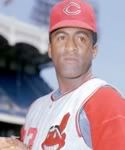

#3 Luis Tiant vs #14 Julio Franco
AC: Maybe one of the bigger surprises of the tournament thus far is the very tight vote between a pair of ageless wonders, Luis Tiant and Juuuuuuulio Franco. Acquired from the Phillies in the infamous Von Hayes trade, Franco wound up finishing runner-up in Rookie of the Year voting in 1983, and proved to be the model of consistency from then on, hitting .298 for his 20+ year career and .297 across his 7 years as an Indian (including a .322 comeback season as the team’s first baseman in 1996). Like Julio, Luis Tiant got his long career started with the Wahoos, posting a less than awe-inspiring record of 75-64 from 1964-1969, but at times looking as dominant as any pitcher in the league. He currently ranks 10th in Indians history in strikeouts, 3rd in K’s per 9inn, and 7th in career WHIP, and his 1968 season (21-9, 1.60 ERA, 264 K’s, 9 shutouts) remains the stuff of legend. All that said, both Tiant and Franco earned wider national fame for their stints with other clubs (Boston and Texas respectively), which tends to go without saying when you’re talking Tribe. JE: Both of these Indians are cases of what could have been. Luis Tiant was great for Boston, but he was even better for Cleveland. If you look past wins and losses, which you have to on those Indians teams of the ‘60s, then you see a dominant starting pitcher. In that ’68 season, he broke Herb Score’s record for fewest hits per nine innings, set the team record for lowest batting average against, and posted the second lowest ERA since the dead ball era, only topped by Bob Gibson (just too bad ’68 is also the year Denny McClain won 31). Though supposedly unrelated to his unorthodox delivery, Tiant faced some injury troubles that led to his trade to Minnesota, which netted the Indians a declining Dean Chance and a young Graig Nettles. 15 years later, Julio Franco gained a reputation for his own unorthodox style, holding the bat high over his head and swinging in a whip-like motion. He was the standout get from the 5 for 1 Hayes trade and earned his keep here in the mid ‘80s. As his stock grew, though, the ever-rebuilding Indians saw no choice but to unload him, acquiring Pete O’Brien, Oddibe McDowell, and “The Governor” Jerry Brown from Texas, none of whom made a long-term impact. Julio, meanwhile, won a batting title for the Rangers, leaving Indians fans to just shake their heads again at the loss of such a talent. In the end, as much as you have to love Julio, you really can’t oust King Luis this early.
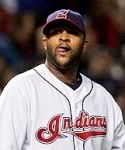
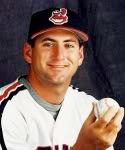
#6 CC Sabathia vs #11 Charles Nagy
JE: I think the correct term for both of these players would be “tease.” I remember it seemed every few years people kept expecting Nagy to break out and be the ace we thought he could be. It was essentially the same story with CC. He was this big hard throwing lefty. He screamed dominant pitcher if you looked at him, but it just never seemed to click completely for either player on a start-to-start basis. Nagy was a very good pitcher but more of a number 2 who would flash brilliance. CC eventually found the ace form enough to win a Cy Young, but to me, the better-looking pitcher that year was actually Fausto Carmona. I just never felt like CC had that ace aura, where a win just felt like it was in the bag when he pitched. I know he’s continued to have great success, but as an Indian, he never quite made the leap to true greatness. In terms of a vote, though, I have to go CC, as he definitely put together a stronger peak year and has better peripheral stats.
AC: This one has already generated a little message board debate, and it’s easy to understand why. On reputation alone, Sabathia cruises to a win here. After all, he was the Tribe ace (regardless of whether he meets Jeff’s Sandy Koufax definition of the word), a Cy Young winner, and --now that he’s a Yankee-- probably a first ballot Hall of Famer. But Jeff is correct in some ways. Neither CC nor Nagy were truly dominant during the majority of their years as the Indians’ #1 guy. They were aces, but rarely top tier. Sabathia was more durable during his 7.5 years here, only missing a handful of starts, but some would argue that Nagy was more consistent, at least in his prime. In any case, the two first round picks rank 10th and 13th in team history in wins, 5th and 6th in strikeouts, and they both made 3 All-Star Games. They also both had their issues in the postseason. All told, Sabathia did his work in 400 fewer innings that Nagy, so even if we call the rest even, CC was the more valuable player.
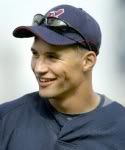
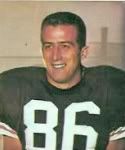
#7 Grady Sizemore vs #10 Gary Collins
AC: This section of the bracket is clearly a tad overstuffed with ’60s Browns players, but that’s just how the cookie crumbled. So, how good was Gary Collins? Most people remember him as the hero of the ’64 NFL Championship Game, but he was a consistent contributor for the Browns for a whole decade, both as one of Frank Ryan’s prime receiving targets, and also as a damn good punter. He’s 4th in Browns history in catches, 5th in receiving yards, and #1 in touchdown catches with 70. Mr. Sizemore’s resume is certainly fresher in our minds, but even as the Indians’ last remaining “franchise player,” his star power has dimmed a tad thanks to injuries and four consecutive years with a 10+ point drop in batting average. Grady remains the classic “five tool” guy, and a 40/40 season isn’t beyond the range of possibility. Five full seasons into his career, though, he might not have the full body of work needed to beat out Cleveland’s last title game MVP—in my mind anyway.
JE: I am going to take that a step further here and say Sizemore should definitely lose this one. Grady has shown a rare mix of power and speed along with a love of the game that has endeared him to the Clevelanders; it also helps when you’re a bit of a pretty boy too, though. He plays hard, so the men love him. He’s cute, so the women love him: win freaking win. I know there has been concern about the drop in batting average, but if you look at the rise in OBP and SLG, it’s clear that he has improved every season. As we all know, average is an out of date stat anyways. If he keeps up his pace, Grady should be the superior player here, but right now, Collins’ nine strong seasons outshine Sizemore’s four. He was Frank Ryan’s go-to receiver in pressure situations, and despite making only 2 Pro Bowls, he made the NFL’s All 1960s team. Collins retired when conflicts with new coach Nick Skorich arose, but his numbers still compare favorably to many of the finest receivers in Browns history. Voting for Sizemore here might just be a bit of a premature coronation.
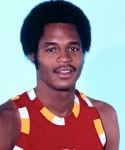
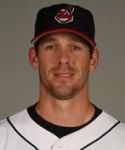
#2 Austin Carr vs #15 Cliff Lee
JE: I have a soft spot for Cliff Lee. When everything fell apart last season, he was the only bright spot. For the first time I could remember, we had a pitcher who made every outing a can’t-miss event. I had been a big proponent of Lee’s for years as Andy could tell you. All young pitchers have their ups and downs, but Cliff finished fifth in Cy Young voting in 2005 and won the thing in his fourth full season in the majors. If you count the year he was hurt and spent time in AAA, then he’s played six seasons to this point and three of them were Top 5 CY Young type of years. I am not sure what more you could want out of a pitcher. In the red corner, Austin Carr was Mr. Cavalier, but was also the first in a long line of injury prone Cavs players. Carr was a pure scorer and one of the best college basketball had ever seen. He was exactly what the Cavs needed for the franchise-- a face and a player who would generate excitement. But then the injuries came. It doesn’t matter if you can score on anyone if you can’t get in the game, and those injuries slowly robbed him of his greatness. In every NCAA tourney, a #15 upsets a #2, and I think this should be the case. I love AC, but Lee was the better player and a player I think Tribe fans will come to appreciate more and more with time. AC: As chairman of the CP Lee Fan Club, Jeff has an obligation to vote for Cliff here, but the southpaw's #15 seeding doesn’t feel all that unjust to me. Without 2008, he doesn’t make the list at all, and it’s kind of hard to count his half season this year as being hugely relevant. In his Cleveland career, he had 2.5 seasons that were better than mediocre: the high run-support season of 2005 (18-5, 3.79), the no run support half-season of 2009 (7-9, 3.14), and of course, 2008 (22-3, 2.54), when Lee enjoyed a ridiculous streak of success that he isn’t likely to duplicate in Philadelphia or anywhere else. Unlike a typical ace, Lee has had a couple seasons in which he was VERY hittable (not just when battling injuries). Meanwhile, Austin Carr’s Achilles heel was never inconsistency or trade chatter—it was just injuries, as Jeff said. Austin missed a lot of time during his 9 years as a Cavalier, but when healthy, he showed why he’d earned legendary status at Notre Dame, averaging over 20 PPG his first three years in Cleveland after being picked #1 overall in 1971. He is still the Cavs’ #3 all-time scorer and 8th in assists, and his #34 hangs from the rafters at the Q, where A.C. has gained a new fanbase for his work in the broadcast booth.
Next week, Round 2 of 64 Since ‘64 begins! We’ll show you the final results from Round 1 voting and take a look at the top half of the 32-man draw that remains.
- NBA Announces 2013-2014 Schedule
- Browns Ink Sharknado
- Sharknado A No-Show For Rookie Camp
- Trent Richardson Out Until Training Camp
- Browns Sign Brandon Jackson
- Carrasco Suspended Eight Games
- Browns Add to Wide Receiver Depth with David Nelson
- Browns Need to Learn from Past Draft Mistakes
- Browns Release Chris Gocong and Usama Young
- Browns Missing on Grimes Disappointing, But Not The End
The TCF Forums
- Movies coming out
rebelwithoutaclue (Tuesday, January 21 2014 12:56 PM) - 2015 Recruiting
jclvd_23 (Tuesday, January 21 2014 12:38 PM) - The 2014 Offseason Thread
Larvell Blanks (Tuesday, January 21 2014 12:25 PM) - Official- Browns Coach Search/Rumors
Larvell Blanks (Tuesday, January 21 2014 11:53 AM) - Chris Grant's first 3 drafts
Kingpin74 (Tuesday, January 21 2014 10:13 AM) - Mike Brown
YahooFanChicago (Monday, January 20 2014 11:15 PM) - 2014 Hoops Hockey Hijinx
jpd1224 (Monday, January 20 2014 4:44 PM) - 2014 Recruiting
jclvd_23 (Monday, January 20 2014 2:26 PM) - Wish List - #4 Pick
Hikohadon (Monday, January 20 2014 1:26 PM) - #1 overall pick Anthony Bennett
TouchEmAllTime (Sunday, January 19 2014 1:28 PM)


